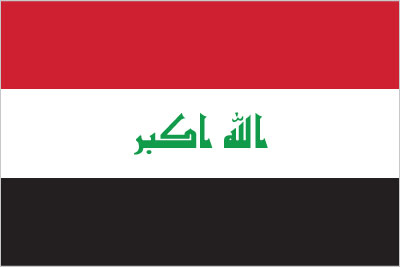Last updated on April 13th, 2019
Iraq, officially known as the Republic of Iraq, is a country in Western Asia. It covers an area of 438,317 square km. Baghdad is its capital and largest city. Arabic & Kurdish are its official languages. Its official currency is Iraqi dinar (IQD). Its six bordering countries are Turkey, Iran, Kuwait, Jordan, Saudi Arabia, and Syria.
Although rich in oil, Iraq has been a war-torn country for years. Let’s explore more about the country that has been under decades of dictatorship, war, and turmoil. Here are some interesting facts about Iraq’s history, geography, culture, government, people, economy, and wars.
Interesting facts about Iraq’s history
1. In Arabic, the name Iraq means “deeply rooted, well watered; fertile.” The name has been in use since before the sixth century.
2. Iraq was under British rule for 17 years, and Ottoman rule for centuries.
3. It gained independence from Britain on October 3, 1932.
Flag of Iraq

4. In 1991 the phrase “Allahu Akbar” was added in green Arabic script to the flag of Iraq. (See the image of Iraq’s flag above)
5. The metric system of weights and measures is the legal standard in the country.
6. Beginning its participation in the Olympic Games in 1948, Iraq has only won a Bronze medal (from the 1960 games) to this day.
About Saddam Hussein
7. General Saddam Hussein became Iraqi dictator in 1979.
8. He (Saddam Hussein) invaded Iran in 1980 and Kuwait in 1990. However, both the invasions were unsuccessful, only draining Iraq of its resources and burdening its economy.
9. Saddam Hussein was hanged on December 30, 2006, for crimes against humanity.

10. During the Iraq-Iran war in the 1980s, Saddam Hussein was an ally of the United States.
11. In the memory of Iraqi soldiers who died during the Iraq-Iran war, a monument—al-Shaheed Monument—was built in Baghdad.
12. Since the Gulf War, an increasing number of women are sold into sex slavery.
About bunkers and underground tunnels in Baghdad
13. The underground bunkers built for Saddam Hussein were said to be virtually indestructible, being able to resist a direct hit by a 2,000-kilo TNT bomb. And the bunkers were as deep as 90 meters under the ground.
14. The company that built bunkers for Saddam Hussein also built air-raid shelters for Adolf Hitler’s Third Reich.
15. The bunker specially built for the fifth President of Iraq (Saddam Hussein) was not just a small space to hide during war time. Moreover, it was equipped with amenities such as a swimming pool, a recreation room, a gourmet kitchen and nursery for Saddam Hussein’s grandchildren.
16. Another addition to this state-of-the-art bunker was the “war room.” The room was studded with the latest technology so that the dictator could monitor activities above the ground.
17. The underground tunnels and bunkers for the Iraqi dictator were built between the 1970s and 1980s by Yugoslav engineers.
18. Baghdad had a fabled and labyrinthine network of underground tunnels that would stretch for kilometers. It had the capability to house thousands of Iraqi people, hospitals and even military command posts.
19. The bunkers and tunnels were built on the order of General Saddam Hussein for his protection in the event of a war. The cost of building these bunkers was paid in the form of oil.
20. Iraq is also home to the world’s first writing system and recorded history.
Related: facts about Syria
Iraq on the map
Geographical facts about Iraq
21. Iraq is a Middle Eastern country, officially called the Republic of Iraq.
22. Baghdad, the capital of Iraq, is situated in the eastern central region of the country.
23. Iraq has a narrow section of coastline measuring 58 km on the northern Persian Gulf.
24. The Tigris and Euphrates are the two major rivers of Iraq. These rivers contribute significantly toward making the land of Iraq very fertile.
25. Mesopotamia, the region (which roughly corresponds to modern-day Iraq, also referred to as the “land amidst the rivers”) between the Tigris and Euphrates Rivers, is considered to be one of the cradles of civilization.
26. Iraq has been home to indigenous Akkadian, Assyrian, Babylonian and Sumerian empires in its history.
. . . continue reading on the next page.
